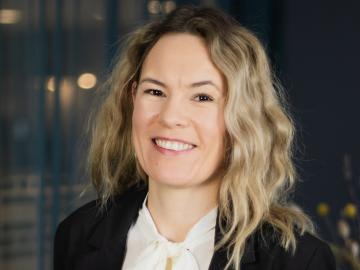Sweden on course to exceed flagship EU environmental targets
RSM a leading provider of professional services to middle market businesses, has found Swededn joins only a third of EU countries set to exceed basic green automobility targets.
The findings came in RSM Netherlands’ latest pan-European Union report, State of play: Sustainable automobility in Europe, to assess the bloc’s automobility transition. The report also concluded that more than a quarter of the EU risks missing key green automobility targets.
Experts conducted detailed analysis of each EU state’s policies, technological and infrastructure development against what is required to meet the European Commission’s transition to sustainable automobility.
Each country’s progress was measured against the European Green Deal, and flagship targets that included the reduction of greenhouse gas emissions, promotion of zero-emission vehicles, electric charging infrastructure and sustainable aviation and maritime transport.
The report additionally highlighted sustainable development challenges over the next seven years in Bulgaria, Latvia and Romania, making the sense of urgency required in their green transitions particularly acute in those countries.
Sweden
Policy Review
Until 2021, Sweden has been at the forefront of promoting sustainability in the automotive and mobility sector through stringent policies and regulations.[1]Sweden's ambitious goal to become carbon neutral by 2045 has catalyzed the former government to implement various initiatives to reduce emissions from vehicles. However, the policies recently announced by the current government are the first policies in the last two decades that will not decrease emissions related to transport, and may even increase emissions in the short term.[2] Plans to increase the travel deduction for trips to work from €1.8 per 10 km to €2.1 and the fuel deduction using a company car from €0.50 per 10 km to €1 will decrease the number of people using public transport. Also, the government reduced the fuel tax on petrol and diesel by €0.069 per litre from 1 January 2023. Lastly, incentives for buying emissions-free and energy-efficient vehicles will be stopped. Maintaining these regulations up to 2030 can increase emissions of up to 1 million tons of CO2.[3]
Sweden Recovery and Resilience Plan
The total value of the plan amounts to € 3.5 billion, out of which 44% will go towards supporting the green transition. Sweden has set an ambitious target to attain carbon neutrality by 2045, necessitating significant reforms and investments across various sectors, notably energy, housing, transport, and industry. In the realm of green transportation, a substantial €148 million investment is earmarked to bolster railway capacity enhancement efforts. Moreover, a reform initiative is underway to incentivize transport decarbonization, involving the elimination of energy tax reductions on fuel and adjustments to taxable benefit rates for company cars. Notably, the revised plan maintains a robust emphasis on advancing the green transition, with 43.6% of available funds allocated to measures supporting climate objectives, exceeding the targeted objective of 37%.[4]
Tax exemptions and subsidies
There are a range of tax exemptions and subsidies available in order to promote the transition to sustainable transport among car owners. Ownership Tax Benefits: Electric vehicles (BEVs) enjoy the lowest ownership tax, approximately €32 annually, while conventional vehicles incur higher taxes, totalling €355 per year. Circulation Tax: BEVs are exempt from circulation tax for five years, providing a benefit of €170 per year. Company Tax Benefits: For company cars, the private use is subject to taxation on benefits. Green cars may receive a permanent tax reduction on the benefit value. BiK taxation grants an average benefit of €270 for a C-segment car, with BEVs receiving a 50% discount on the tax base calculation, resulting in a maximum reduction of €30,550. Purchase Subsidies: No subsidies are available for cars registered after November 8, 2022. BEVs registered before this date receive reduced bonus amounts, with a maximum of €4,365 for stock models. From 2023, cars emitting a maximum of 30g CO2/km are eligible for subsidies. Other Financial Benefits: Electric and plug-in hybrid electric vehicles (PHEVs) benefit from reduced company car taxation. The taxable value of these vehicles for calculating the benefit-in-kind under personal income tax is reduced to that of a comparable petrol or diesel car, with an additional 40% reduction (up to €10,000) valid until 2020, subject to political decisions for extension.
Technological Advancements
The automotive industry in Sweden has seen significant advancements in electric and autonomous vehicle technologies. Leading companies like Volvo and Scania have invested heavily in developing electric and hybrid vehicles, along with autonomous driving features. Additionally, Sweden is a hub for innovation in battery technology, with companies like Northvolt leading the way in sustainable battery production.[5] For example, in 2022, Volvo and Northvolt joined their powers by opening an R&D centre in Gothenbourg to focus on battery development[6].
Sweden is making strides in sustainable transportation with the construction of the world's inaugural permanent electric road, designed to charge electric vehicles while they're in motion. Having already experimented with temporary electrified roads in cities like Lund, Southern Sweden, the country is now embarking on a 21 km (13-mile) stretch of roadway that will serve as a lasting solution. Led by the Swedish transport administration Trafikverket, the project is currently in the process of selecting the specific charging technology, options include overhead power lines akin to tram systems, ground-level electric rails embedded in the road, or road-embedded inductive coils that transfer power to vehicles. Situated on the E20 motorway between Hallsberg and Örebro, the chosen location is a bustling traffic corridor for commercial goods transport, spanning from Stockholm to Malmö. Scheduled for completion by 2025, the electrified highway is poised to play a pivotal role in Sweden's transition to EVs, potentially leading to smaller battery sizes and enhanced sustainability.[7]
Infrastructure Development
The Swedish government has prioritized infrastructure development to support sustainable mobility. In 2023, the government set aside €78.04 million and for 2024, the government has planned to invest €867 million. Investments have been made in expanding public transportation networks, building bike lanes, and developing charging infrastructure for EVs. In stride with this, the current government transferred €650 million in the state budget for railway maintenance to road maintenance.[8] Efforts are also underway to integrate smart technology into infrastructure to improve traffic flow and reduce congestion.
EV Charging Infrastructure
Sweden boasts an extensive EV charging network, with both public and private entities investing in charging stations. The investment plans stated in the previous paragraph also include quick charging stations. Moreover, the government offers subsidies for installing charging infrastructure, home chargers are subsidized for 50% up to €960.[9] Initiatives like the Swedish Charging Infrastructure Council work to standardize charging protocols and improve accessibility[10]. Research has shown that Sweden is among the top four countries regarding EV adoption and EV charging infrastructure, with 265 available EV charging station for every 100,000 people.[11]
Railway Infrastructure
Sweden's railway system is undergoing significant upgrades, with a 25% increase in funding allocated for the maintenance of state-owned railways, amounting to approximately €3.9 billion during the planning period. This surge in resources aims to minimize long-term maintenance costs and enhance service reliability by prioritizing timely maintenance activities. Investments are focused on four designated transport corridors, including the Western Mainline, Southern Mainline, northern rail freight corridor, and the Iron Ore Line, to improve infrastructure robustness and reduce maintenance backlog.[12]
Over 80 percent of the allocated funds are directed towards railway network improvements, with substantial investments in new high-speed rail mainlines and railway engineering systems, including the adoption of the digital ERTMS signal system, within a 2040-2045 timline. However, due to challenges in the ongoing planning process for certain sections, adjustments are proposed, with approximately €10.2 billion allocated for new mainlines during the planning period. Efforts are also intensified to reduce investment costs, aiming to lower system-wide expenses by approximately €6.4 billion compared to current estimates. Additionally, loan-financed measures are proposed to increase capacity on the Iron Ore Line, alongside plans to enhance speeds on key routes and modernize station infrastructure to accommodate longer and heavier trains.[13]
Market Trends and Consumer Behavior
The demand for electric vehicles in Sweden has been steadily increasing, driven by government incentives, environmental awareness, and technological advancements.[14] Sales of EVs have outpaced traditional vehicles in recent years, making Sweden the runner-up of electric car share in European countries.[15] As seen in the technological advancements, automakers are responding by expanding their electric vehicle offerings.
However, the demand for SUVs has seen a spike in 2022, accounting for more than 25% of all cars produced after 2020.[16] Due to their weight, SUVs are related to higher emissions. Even though electric SUVs would seem the solution, the need for critical minerals in the production process hurts the overall supply chain.
Public Transportation
Sweden has a well-developed public transportation system, with trains, buses, trams, and ferries connecting urban centres and remote regions. Investments in infrastructure and technology have improved the efficiency and sustainability of public transit, making it an attractive option for commuters. In 2022, 6.4% of the buses were fully electric buses.[17] The government is still planning on investing in public transportation and increasing incentives for bicycle and pedestrian modes of transport.[18]
Sweden aims for public transport to make up 40% of all transport modes by 2030. However, from 2019, with 32%, Sweden has seen a decrease in public transportation use of 20% in 2021 and 28% in 2022. So, the use of public transportation is slowly rising again, but not at the pre-pandemic level yet.[19]
In Sweden, public transportation encompasses various levels, including local and regional, interregional, and international services. Governed by the Public Transportation Act, local and regional public transport is regulated to meet the daily travel needs of commuters and residents within a county or across multiple counties. It aims to provide accessible and efficient services for work commutes and other routine travel requirements. The utilization of local and regional public transport in Sweden has been on a consistent rise. Since 2014, there has been a notable increase in national usage, a 28% growth over a decade, indicating a growing reliance on public transportation for everyday travel needs.[20]
Environmental Impact
The shift towards sustainable mobility, like more EVs and increased public transportation use, has had a positive environmental impact, reducing greenhouse gas emissions and air pollution. Efforts to promote a modal shift towards public transportation and active modes of transport further contribute to reducing the carbon footprint of the transportation sector.[21] In 2021, 15.44 million tons of CO2 equivalent came from transportation. The last couple of years show a slow but steady decrease in those emissions, from 19.57 million tons in 2012 to 15.44 million tons in 2021.[22]
Economic and Social Implications
In 2021, 13.8% of manufacturing jobs in Sweden are related to the automotive industry in Europe.[23] Moreover, while most Swedish citizens have to commute between 1 and 29 minutes to work, there is also a significant amount of citizens who have to travel between 30 and 59 minutes. [24]
Best Practices and Case Studies
Sweden's approach to sustainable mobility serves as a model for other countries. The integration of public transportation, cycling infrastructure, and EV incentives has led to tangible reductions in emissions and congestion. Case studies like Stockholm's traffic congestion fees demonstrate the effectiveness of innovative policies in promoting sustainable transportation.[25] However, when implementing traffic congestion fees, countries should account for and act upon the increased demand for public transportation and biking possibilities.
Also, to cope with the increasing demand for SUVs, the government should implement a weight-based tax on SUVs, like France.[26]
Future Perspectives and Emerging Trends
Sweden's automotive and mobility industry is poised for transformative growth with a push towards electric vehicles (EVs) and autonomous driving technologies. The country's commitment to sustainability is evident in its ambitious 2025 goals, including the launch of electric road pilots and advanced hydrogen refuelling stations. Emerging trends include shared mobility services, electric aviation, and sustainable logistics solutions. Despite challenges like raw material scarcity for EV batteries, Sweden's innovative approach and robust infrastructure for EV charging continue to drive the market forward. This momentum is underpinned by the Swedish population's environmental awareness and the government's strategic initiatives to enhance sustainable mobility. [27] [28]
International Comparisons and Collaborations
Sweden's collaboration within the CollERS partnership, which involves Germany and France, underscores a shared commitment to the electrification of roads. This innovative alliance aims to spearhead the development and deployment of electric road systems, potentially setting a new standard for sustainable transportation in Europe. By pooling resources, expertise, and technological advancements, the countries involved hope to accelerate the transition to greener mobility solutions, demonstrating a united front in the fight against climate change and dependence on fossil fuels.[29]
READ FULL REPORT HERE
[2] Swedish Climate Policy Counsel, Report of the Swedish Climate Policy Counsel 2023 (klimatpolitiskaradet.se)
[5] Swedish Climate Policy Counsel, Report of the Swedish Climate Policy Counsel 2023 (klimatpolitiskaradet.se)
[6] Volvo Cars and Northvolt to open Gothenburg R&D centre as part of SEK 30bn investment in battery development and manufacturing - Volvo Cars Global Media Newsroom
[7] Sweden is building the world's first permanent electric road that charges moving EVs (electrek.co)
[8]Swedish Climate Policy Counsel, Report of the Swedish Climate Policy Counsel 2023 (klimatpolitiskaradet.se)
[10] Swedish environmental Protection Agency, Car Charging (2024) (naturvardsverket.se)
[18] Swedish Climate Policy Counsel, Report of the Swedish Climate Policy Counsel 2023 (klimatpolitiskaradet.se)
[19] Stockholm Environment Institute, Accelerating Sweden’s climate action in transportation (2023)
[20] SMARTA, Sweden Insight Paper (2020) (ruralsharedmobility.eu)
[21] Swedish Climate Policy Counsel, Report of the Swedish Climate Policy Counsel 2023 (klimatpolitiskaradet.se)
[26] Stockholm Environment Institute, Accelerating Sweden’s climate action in transportation (2023)
[27] Nordic Investment Bank , The future of mobility (2023) (nib.int)
[29] International Research Collaboration on Electric Road Systems II (CollERS 2)






